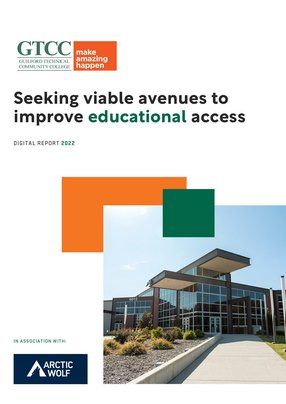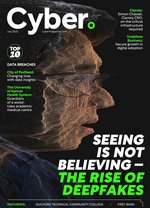GTCC: seeking viable avenues to improve educational access
Guilford Technical Community College (GTCC) is one of the largest community colleges in the US state of North Carolina, typically ranking fourth for the largest community college in the state, with nearly 27,000 registered students annually.
“We've been around since the late ‘50s,” says Horn. “There are five campuses here in Guilford County, which is part of what they call 'the triad' region. Our programs include many traditional education opportunities, like associates and transfer degrees. But we also offer many skilled trade options, like advanced manufacturing, CDL or truck-driving training, welding, automotive, healthcare and also, quite uniquely, we have aviation, with a large aviation program that's still growing.”
Community colleges are generally recognized for providing what’s known as ‘workforce education’, however, since the ‘T’ in ‘GTCC’ stands for ‘technical’ – and thanks to Ron Horn, many developments are taking place in terms of the types of courses that are now being offered.
“I currently oversee about 30 permanent employees in the areas of infrastructure, security, networking, telephony service, delivery, application support and project management.”
Innovative courses at GTCC
“I have taken advantage of the opportunity to be able to contribute from a very non-traditional CIO perspective, bringing outstanding programs to the school – like 3D printing, autonomous vehicles, blockchain and micro-credentials or micro-certifications, Amazon web services (AWS) – and I have been partnering with agencies that are geared much more towards the community college environment.”
This innovative development also acts as a bridge between the ‘community’ and ‘technical’ aspects of GTCC, combining the social orientation of the spirit of a community college with innovation so that both ends of the equation may benefit.
“We have a large student population who suffer financially,” says Horn. “They don't have the financial resources that are available to a lot of students in other circumstances. We noticed, especially when the pandemic came around, that there was a large drop-off in a certain male sector of students, and soon discovered that they weren't re-enrolling because they had to go back to work, because other household members were now unemployed due to COVID.”
Education and wellbeing
Since this realization, Horn’s focus has been on creating viable programmes to counteract and resolve these issues from educational, career, financial and even familial perspectives. He’s intent on making college more accessible for those impacted by the pandemic, and those for whom the pandemic highlighted an already-existing conflict between education and financial concerns.
He says: “Now, with these new courses, a student doesn't have to go through a complete two-year programme to earn their certificate; instead, they can go through these boot-camp-like, condensed courses to generate a nationally recognised certificate, which will enable them to efficiently access gainful employment and start earning an income for their families on a much shorter time scale.”
An impressive approach to problem-solving, it serves to accentuate the relationship between access to education and social mobility, as well as critical family matters that, when considered together, have obvious interrelated impacts on issues such as mental health and emotional wellbeing.
Motivation and inspiration
It was natural, therefore, to enquire about Horn’s motivations when it comes to problem-solving and thinking outside of the box.
When asked what inspires him to come to work every day, he says: “I think this may sound a little strange, but it’s the thought of the unknown and not knowing what to expect that’s a major motivational force for me. I've worked in a lot of different industries and, at one point in my career, I even worked in the federal prison industry. The first time the doors shut on me, it really jolted me and gave me a dose of reality.
“But then, after getting up and going to work every day not knowing what to expect was kind of exciting and even thrilling for me. In a very similar fashion (but on a much lower key, of course), it's the same for me today. When I get up every day not knowing really what to expect, that excites me, because it makes me think creatively and keeps me on my toes.”
Horn says that his inspiration also comes from the opportunity for people to learn and advance their careers. “From a leadership perspective,” he says, “I take the time to meet each one of my staff members and to spend time with them; asking them questions like: 'What is it that motivates you to come to work every day?', 'What do you like?', 'What don't you like?', 'What leadership style do you like?' and, essentially, I really want to help people to grow.”
Expansion of the educational environment through technology
As CIO, Horn knows, of course, that behind the people – whether they be student or staff member – there is a technological and informational highway that allows them to connect and thrive in GTCC’s environment. And, precisely because of those technologies and innovations, the very concept of the educational environment itself expands beyond its mere physical boundaries, redefining the educational milieu altogether.
Horn observes that, while most higher education institutions have not traditionally looked at mobile-first and cloud-first environments, his approach from the start was – in terms of a data-based perspective – transformational from the beginning.
“I think it's been an option for many higher education institutions and something that they initially wanted to merely dip their toes in, if you will, just a little bit at a time to test the temperature of the water. But when I came on board, I was immediately focused on moving as much data as I could to the cloud. That made sense for the business, and it didn't create any additional risk. So, I evaluated what data we were moving and how it was to be protected. That was my cloud-first strategy from the beginning.
“Then there are mobile-first tools. We are in a highly mobile environment, and most people carry around a cell phone, which is their access-point to data 24/7. So, as an organisation, you must be able to deliver the data to the customer, which, in our case, is our students.
“We've really laser-focused on allowing the students to access every piece of information on their phones and to be able to do everything they need from these devices.”
Technology and student enrolment
Technology not only serves to improve the educational possibilities of students and learners, but it also serves to increase the number of students that enroll on the courses overall.
“No longer are you focused just on the students that are in your local area, such as those that can commute back and forth to your campus,” Horn says. “But now that the borders have been removed, it also creates a different competitive landscape.
“This makes it important to be able to convince students of why it's a wise choice for them to attend Guilford Technical Community College. Therein lies the importance of your messaging and how you differentiate yourself from other colleges.”
GTCC has, as a result, increased its online presence and developed the systems that allow students to complete their coursework online.
Horn says: “I think that the pandemic has just accelerated this transition – I think that these thoughts, ideas, movements and strategies were already there, but that COVID has acted as a catalyst. So, our college is focused on that delivery, while retaining our traditional infrastructure and our campuses, which are going to continue to be available for the students in the local area.
“We're also going to continue to look at our strategy as to how we deliver online, what we deliver online and how we differentiate ourselves from other schools.”
Cybersecurity and partnership with Arctic Wolf
Speaking on the college’s partner ecosystem, Horn underlines that, most importantly, GTCC looks for organisations that closely understand GTCC’s business, strategy, audience and demographic.
“What we are specifically looking for is alignment,” he says. “We don't want a company that we just write a cheque to every month or year. Vendor partners mean something to us; they are organizations that we have frequent conversations and meetings with and where we talk about strategy.
“And I think that's one of the things that we saw with Arctic Wolf.”
Arctic Wolf provides a critical managed detection and response (MDR) framework, which plays a crucial role in the cybersecurity and risk management of GTCC’s systems.
In terms of cybersecurity, Horn refers to the CIA’s triad of ‘Confidentiality, Integrity and Availability’, noting that “those really ring true to our mission here at GTCC, in making sure that we maintain our students, faculty and staff privacy, and access to their data”.
Horn continues: “Arctic Wolf is an organisation that I could have those conversations with and that I developed those relationships with, so that they understand who we are, what our mission is, what our focus is and where we're going.
“Arctic Wolf have been very supportive and transparent, and we've had a lot of conversations where they're open to feedback. They're willing to work with us and to refine the tools and processes that we need, for our organisation to move forward.”
GTCC will continue to focus on automation, simplification and standardization of their tool sets, and will focus on decreasing such overheads – from a staffing-resources perspective – so that they can focus on further innovation and on dreaming up fresh approaches and systems to enhance innovations at the college.






